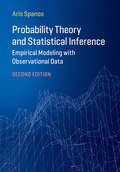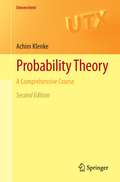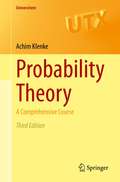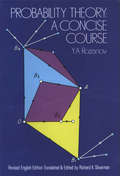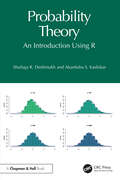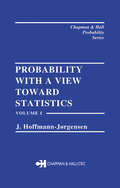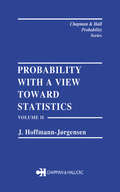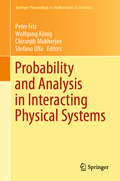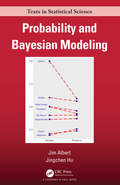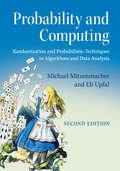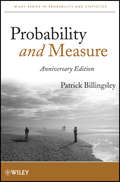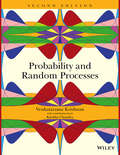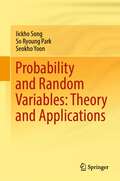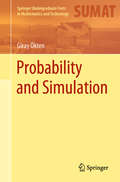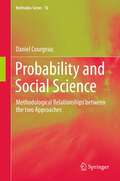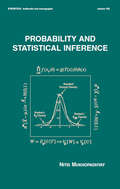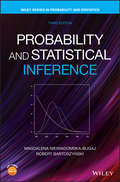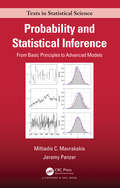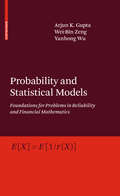- Table View
- List View
Probability Theory and Statistical Inference: Empirical Modeling with Observational Data
by Aris SpanosDoubt over the trustworthiness of published empirical results is not unwarranted and is often a result of statistical mis-specification: invalid probabilistic assumptions imposed on data. Now in its second edition, this bestselling textbook offers a comprehensive course in empirical research methods, teaching the probabilistic and statistical foundations that enable the specification and validation of statistical models, providing the basis for an informed implementation of statistical procedure to secure the trustworthiness of evidence. Each chapter has been thoroughly updated, accounting for developments in the field and the author's own research. The comprehensive scope of the textbook has been expanded by the addition of a new chapter on the Linear Regression and related statistical models. This new edition is now more accessible to students of disciplines beyond economics and includes more pedagogical features, with an increased number of examples as well as review questions and exercises at the end of each chapter.
Probability Theory the Logic of Science
by E. T. JaynesThe standard rules of probability can be interpreted as uniquely valid principles in logic. In this book, E. T. Jaynes dispels the imaginary distinction between 'probability theory' and 'statistical inference', leaving a logical unity and simplicity, which provides greater technical power and flexibility in applications. This book goes beyond the conventional mathematics of probability theory, viewing the subject in a wider context. New results are discussed, along with applications of probability theory to a wide variety of problems in physics, mathematics, economics, chemistry and biology. It contains many exercises and problems, and is suitable for use as a textbook on graduate level courses involving data analysis. The material is aimed at readers who are already familiar with applied mathematics at an advanced undergraduate level or higher. The book will be of interest to scientists working in any area where inference from incomplete information is necessary.
Probability Theory: A Comprehensive Course
by Achim KlenkeThis second edition of the popular textbook contains a comprehensive course in modern probability theory. Overall, probabilistic concepts play an increasingly important role in mathematics, physics, biology, financial engineering and computer science. They help us in understanding magnetism, amorphous media, genetic diversity and the perils of random developments at financial markets, and they guide us in constructing more efficient algorithms. To address these concepts, the title covers a wide variety of topics, many of which are not usually found in introductory textbooks, such as: * limit theorems for sums of random variables * martingales * percolation * Markov chains and electrical networks * construction of stochastic processes * Poisson point process and infinite divisibility * large deviation principles and statistical physics * Brownian motion * stochastic integral and stochastic differential equations. The theory is developed rigorously and in a self-contained way, with the chapters on measure theory interlaced with the probabilistic chapters in order to display the power of the abstract concepts in probability theory. This second edition has been carefully extended and includes many new features. It contains updated figures (over 50), computer simulations and some difficult proofs have been made more accessible. A wealth of examples and more than 270 exercises as well as biographic details of key mathematicians support and enliven the presentation. It will be of use to students and researchers in mathematics and statistics in physics, computer science, economics and biology.
Probability Theory: A Comprehensive Course (Universitext)
by Achim KlenkeThis popular textbook, now in a revised and expanded third edition, presents a comprehensive course in modern probability theory.Probability plays an increasingly important role not only in mathematics, but also in physics, biology, finance and computer science, helping to understand phenomena such as magnetism, genetic diversity and market volatility, and also to construct efficient algorithms. Starting with the very basics, this textbook covers a wide variety of topics in probability, including many not usually found in introductory books, such as: limit theorems for sums of random variables martingales percolation Markov chains and electrical networks construction of stochastic processes Poisson point process and infinite divisibility large deviation principles and statistical physics Brownian motion stochastic integrals and stochastic differential equations. The presentation is self-contained and mathematically rigorous, with the material on probability theory interspersed with chapters on measure theory to better illustrate the power of abstract concepts.This third edition has been carefully extended and includes new features, such as concise summaries at the end of each section and additional questions to encourage self-reflection, as well as updates to the figures and computer simulations. With a wealth of examples and more than 290 exercises, as well as biographical details of key mathematicians, it will be of use to students and researchers in mathematics, statistics, physics, computer science, economics and biology.
Probability Theory: A Concise Course
by Y. A. RozanovThis book, a concise introduction to modern probability theory and certain of its ramifications, deals with a subject indispensable to natural scientists and mathematicians alike. Here the readers, with some knowledge of mathematics, will find an excellent treatment of the elements of probability together with numerous applications. Professor Y. A. Rozanov, an internationally known mathematician whose work in probability theory and stochastic processes has received wide acclaim, combines succinctness of style with a judicious selection of topics. His book is highly readable, fast-moving, and self-contained.The author begins with basic concepts and moves on to combination of events, dependent events and random variables. He then covers Bernoulli trials and the De Moivre-Laplace theorem, which involve three important probability distributions (binomial, Poisson, and normal or Gaussian). The last three chapters are devoted to limit theorems, a detailed treatment of Markov chains, continuous Markov processes. Also included are appendixes on information theory, game theory, branching processes, and problems of optimal control. Each of the eight chapters and four appendixes has been equipped with numerous relevant problems (150 of them), many with hints and answers. This volume is another in the popular series of fine translations from the Russian by Richard A. Silverman. Dr. Silverman, a former member of the Courant Institute of Mathematical Sciences of New York University and the Lincoln Laboratory of the Massachusetts Institute of Technology, is himself the author of numerous papers on applied probability theory. He has heavily revised the English edition and added new material. The clear exposition, the ample illustrations and problems, the cross-references, index, and bibliography make this book useful for self-study or the classroom.
Probability Theory: An Introduction Using R
by Shailaja R. Deshmukh Akanksha S. KashikarThis book introduces Probability Theory with R software and explains abstract concepts in a simple and easy-to-understand way by combining theory and computation. It discusses conceptual and computational examples in detail, to provide a thorough understanding of basic techniques and develop an enjoyable read for students seeking suitable material for self-study. It illustrates fundamental concepts including fields, sigma-fields, random variables and their expectations, various modes of convergence of a sequence of random variables, laws of large numbers and the central limit theorem. Computational exercises based on R software are included in each Chapter Includes a brief introduction to the basic functions of R software for beginners in R and serves as a ready reference Includes Numerical computations, simulation studies, and visualizations using R software as easy tools to explain abstract concepts Provides multiple-choice questions for practice Incorporates self-explanatory R codes in every chapter This textbook is for advanced students, professionals, and academic researchers of Statistics, Biostatistics, Economics and Mathematics.
Probability With a View Towards Statistics, Volume I (Chapman And Hall/crc Probability Ser.)
by J. Hoffman-JorgensenVolume I of this two-volume text and reference work begins by providing a foundation in measure and integration theory. It then offers a systematic introduction to probability theory, and in particular, those parts that are used in statistics. This volume discusses the law of large numbers for independent and non-independent random variables, transforms, special distributions, convergence in law, the central limit theorem for normal and infinitely divisible laws, conditional expectations and martingales. Unusual topics include the uniqueness and convergence theorem for general transforms with characteristic functions, Laplace transforms, moment transforms and generating functions as special examples. The text contains substantive applications, e.g., epidemic models, the ballot problem, stock market models and water reservoir models, and discussion of the historical background. The exercise sets contain a variety of problems ranging from simple exercises to extensions of the theory.
Probability With a View Towards Statistics, Volume II
by J. Hoffman-JorgensenVolume II of this two-volume text and reference work concentrates on the applications of probability theory to statistics, e.g., the art of calculating densities of complicated transformations of random vectors, exponential models, consistency of maximum estimators, and asymptotic normality of maximum estimators. It also discusses topics of a pure probabilistic nature, such as stochastic processes, regular conditional probabilities, strong Markov chains, random walks, and optimal stopping strategies in random games. Unusual topics include the transformation theory of densities using Hausdorff measures, the consistency theory using the upper definition function, and the asymptotic normality of maximum estimators using twice stochastic differentiability. With an emphasis on applications to statistics, this is a continuation of the first volume, though it may be used independently of that book. Assuming a knowledge of linear algebra and analysis, as well as a course in modern probability, Volume II looks at statistics from a probabilistic point of view, touching only slightly on the practical computation aspects.
Probability and Analysis in Interacting Physical Systems: In Honor of S.R.S. Varadhan, Berlin, August, 2016 (Springer Proceedings in Mathematics & Statistics #283)
by Wolfgang König Stefano Olla Peter Friz Chiranjib MukherjeeThis Festschrift on the occasion of the 75th birthday of S.R.S. Varadhan, one of the most influential researchers in probability of the last fifty years, grew out of a workshop held at the Technical University of Berlin, 15–19 August, 2016. This volume contains ten research articles authored by several of Varadhan's former PhD students or close collaborators. The topics of the contributions are more or less closely linked with some of Varadhan's deepest interests over the decades: large deviations, Markov processes, interacting particle systems, motions in random media and homogenization, reaction-diffusion equations, and directed last-passage percolation. The articles present original research on some of the most discussed current questions at the boundary between analysis and probability, with an impact on understanding phenomena in physics. This collection will be of great value to researchers with an interest in models of probability-based statistical mechanics.
Probability and Bayesian Modeling (Chapman & Hall/CRC Texts in Statistical Science)
by Jim Albert Jingchen HuProbability and Bayesian Modeling is an introduction to probability and Bayesian thinking for undergraduate students with a calculus background. The first part of the book provides a broad view of probability including foundations, conditional probability, discrete and continuous distributions, and joint distributions. Statistical inference is presented completely from a Bayesian perspective. The text introduces inference and prediction for a single proportion and a single mean from Normal sampling. After fundamentals of Markov Chain Monte Carlo algorithms are introduced, Bayesian inference is described for hierarchical and regression models including logistic regression. The book presents several case studies motivated by some historical Bayesian studies and the authors’ research. This text reflects modern Bayesian statistical practice. Simulation is introduced in all the probability chapters and extensively used in the Bayesian material to simulate from the posterior and predictive distributions. One chapter describes the basic tenets of Metropolis and Gibbs sampling algorithms; however several chapters introduce the fundamentals of Bayesian inference for conjugate priors to deepen understanding. Strategies for constructing prior distributions are described in situations when one has substantial prior information and for cases where one has weak prior knowledge. One chapter introduces hierarchical Bayesian modeling as a practical way of combining data from different groups. There is an extensive discussion of Bayesian regression models including the construction of informative priors, inference about functions of the parameters of interest, prediction, and model selection. The text uses JAGS (Just Another Gibbs Sampler) as a general-purpose computational method for simulating from posterior distributions for a variety of Bayesian models. An R package ProbBayes is available containing all of the book datasets and special functions for illustrating concepts from the book. A complete solutions manual is available for instructors who adopt the book in the Additional Resources section.
Probability and Computing
by Michael Mitzenmacher Eli UpfalRandomization and probabilistic techniques play an important role in modern computer science, with applications ranging from combinatorial optimization and machine learning to communication networks and secure protocols. This 2005 textbook is designed to accompany a one- or two-semester course for advanced undergraduates or beginning graduate students in computer science and applied mathematics. It gives an excellent introduction to the probabilistic techniques and paradigms used in the development of probabilistic algorithms and analyses. It assumes only an elementary background in discrete mathematics and gives a rigorous yet accessible treatment of the material, with numerous examples and applications. The first half of the book covers core material, including random sampling, expectations, Markov's inequality, Chevyshev's inequality, Chernoff bounds, the probabilistic method and Markov chains. The second half covers more advanced topics such as continuous probability, applications of limited independence, entropy, Markov chain Monte Carlo methods and balanced allocations. With its comprehensive selection of topics, along with many examples and exercises, this book is an indispensable teaching tool.
Probability and Computing
by Michael Mitzenmacher Eli UpfalRandomization and probabilistic techniques play an important role in modern computer science, with applications ranging from combinatorial optimization and machine learning to communication networks and secure protocols. This 2005 textbook is designed to accompany a one- or two-semester course for advanced undergraduates or beginning graduate students in computer science and applied mathematics. It gives an excellent introduction to the probabilistic techniques and paradigms used in the development of probabilistic algorithms and analyses. It assumes only an elementary background in discrete mathematics and gives a rigorous yet accessible treatment of the material, with numerous examples and applications. The first half of the book covers core material, including random sampling, expectations, Markov's inequality, Chevyshev's inequality, Chernoff bounds, the probabilistic method and Markov chains. The second half covers more advanced topics such as continuous probability, applications of limited independence, entropy, Markov chain Monte Carlo methods and balanced allocations. With its comprehensive selection of topics, along with many examples and exercises, this book is an indispensable teaching tool.
Probability and Conditional Expectation: Fundamentals for the Empirical Sciences
by Rolf Steyer Werner NagelProbability and Conditional Expectations bridges the gap between books on probability theory and statistics by providing the probabilistic concepts estimated and tested in analysis of variance, regression analysis, factor analysis, structural equation modeling, hierarchical linear models and analysis of qualitative data. The authors emphasize the theory of conditional expectations that is also fundamental to conditional independence and conditional distributions. Probability and Conditional Expectations Presents a rigorous and detailed mathematical treatment of probability theory focusing on concepts that are fundamental to understand what we are estimating in applied statistics. Explores the basics of random variables along with extensive coverage of measurable functions and integration. Extensively treats conditional expectations also with respect to a conditional probability measure and the concept of conditional effect functions, which are crucial in the analysis of causal effects. Is illustrated throughout with simple examples, numerous exercises and detailed solutions. Provides website links to further resources including videos of courses delivered by the authors as well as R code exercises to help illustrate the theory presented throughout the book.
Probability and Evidence
by Paul HorwichIn this volume, which was originally published in 1982, Paul Horwich presents a clear and unified approach to a number of problems in the philosophy of science. He diagnoses the failure of other attempts to resolve them as stemming from a too-rigid, all-or-nothing conception of belief, and adopts instead a Bayesian strategy, emphasising the degree of confidence to which we are entitled the light of scientific evidence. This probabilistic approach, he argues, yields a more complete understanding of the assumptions and procedures characteristic of scientific reasoning. It also accounts for the merits of simplicity, severe tests and surprising predictions, and provides a way in which the dispute between the realist and instrumentalist views of science might be resolved. The result is a crisp, well-focused contribution to the philosophy of science. The elaboration of an important conception of probability will stimulate anyone with an interest in the field.
Probability and Forensic Evidence: Theory, Philosophy, and Applications
by Ronald Meester Klaas SlootenThis book addresses the role of statistics and probability in the evaluation of forensic evidence, including both theoretical issues and applications in legal contexts. It discusses what evidence is and how it can be quantified, how it should be understood, and how it is applied (and, sometimes, misapplied). After laying out their philosophical position, the authors begin with a detailed study of the likelihood ratio. Following this grounding, they discuss applications of the likelihood ratio to forensic questions, in the abstract and in concrete cases. The analysis of DNA evidence in particular is treated in great detail. Later chapters concern Bayesian networks, frequentist approaches to evidence, the use of belief functions, and the thorny subject of database searches and familial searching. Finally, the authors provide commentary on various recommendation reports for forensic science. Written to be accessible to a wide audience of applied mathematicians, forensic scientists, and scientifically-oriented legal scholars, this book is a must-read for all those interested in the mathematical and philosophical foundations of evidence and belief.
Probability and Measure (Wiley Series in Probability and Statistics #939)
by Patrick BillingsleyPraise for the Third Edition "It is, as far as I'm concerned, among the best books in math ever written....if you are a mathematician and want to have the top reference in probability, this is it." (Amazon.com, January 2006) A complete and comprehensive classic in probability and measure theory Probability and Measure, Anniversary Edition by Patrick Billingsley celebrates the achievements and advancements that have made this book a classic in its field for the past 35 years. Now re-issued in a new style and format, but with the reliable content that the third edition was revered for, this Anniversary Edition builds on its strong foundation of measure theory and probability with Billingsley's unique writing style. In recognition of 35 years of publication, impacting tens of thousands of readers, this Anniversary Edition has been completely redesigned in a new, open and user-friendly way in order to appeal to university-level students. This book adds a new foreward by Steve Lally of the Statistics Department at The University of Chicago in order to underscore the many years of successful publication and world-wide popularity and emphasize the educational value of this book. The Anniversary Edition contains features including: An improved treatment of Brownian motion Replacement of queuing theory with ergodic theory Theory and applications used to illustrate real-life situations Over 300 problems with corresponding, intensive notes and solutions Updated bibliography An extensive supplement of additional notes on the problems and chapter commentaries Patrick Billingsley was a first-class, world-renowned authority in probability and measure theory at a leading U.S. institution of higher education. He continued to be an influential probability theorist until his unfortunate death in 2011. Billingsley earned his Bachelor's Degree in Engineering from the U.S. Naval Academy where he served as an officer. he went on to receive his Master's Degree and doctorate in Mathematics from Princeton University.Among his many professional awards was the Mathematical Association of America's Lester R. Ford Award for mathematical exposition. His achievements through his long and esteemed career have solidified Patrick Billingsley's place as a leading authority in the field and been a large reason for his books being regarded as classics. This Anniversary Edition of Probability and Measure offers advanced students, scientists, and engineers an integrated introduction to measure theory and probability. Like the previous editions, this Anniversary Edition is a key resource for students of mathematics, statistics, economics, and a wide variety of disciplines that require a solid understanding of probability theory.
Probability and Random Processes
by Kavitha Chandra Venkatarama KrishnanThe second edition enhanced with new chapters, figures, and appendices to cover the new developments in applied mathematical functions This book examines the topics of applied mathematical functions to problems that engineers and researchers solve daily in the course of their work. The text covers set theory, combinatorics, random variables, discrete and continuous probability, distribution functions, convergence of random variables, computer generation of random variates, random processes and stationarity concepts with associated autocovariance and cross covariance functions, estimation theory and Wiener and Kalman filtering ending with two applications of probabilistic methods. Probability tables with nine decimal place accuracy and graphical Fourier transform tables are included for quick reference. The author facilitates understanding of probability concepts for both students and practitioners by presenting over 450 carefully detailed figures and illustrations, and over 350 examples with every step explained clearly and some with multiple solutions. Additional features of the second edition of Probability and Random Processes are: Updated chapters with new sections on Newton-Pepys' problem; Pearson, Spearman, and Kendal correlation coefficients; adaptive estimation techniques; birth and death processes; and renewal processes with generalizations A new chapter on Probability Modeling in Teletraffic Engineering written by Kavitha Chandra An eighth appendix examining the computation of the roots of discrete probability-generating functions With new material on theory and applications of probability, Probability and Random Processes, Second Edition is a thorough and comprehensive reference for commonly occurring problems in probabilistic methods and their applications.
Probability and Random Processes for Electrical and Computer Engineers
by John A. GubnerThe theory of probability is a powerful tool that helps electrical and computer engineers to explain, model, analyze, and design the technology they develop. The text begins at the advanced undergraduate level, assuming only a modest knowledge of probability, and progresses through more complex topics mastered at graduate level. The first five chapters cover the basics of probability and both discrete and continuous random variables. The later chapters have a more specialized coverage, including random vectors, Gaussian random vectors, random processes, Markov Chains, and convergence. Describing tools and results that are used extensively in the field, this is more than a textbook; it is also a reference for researchers working in communications, signal processing, and computer network traffic analysis. With over 300 worked examples, some 800 homework problems, and sections for exam preparation, this is an essential companion for advanced undergraduate and graduate students. Further resources for this title, including solutions (for Instructors only), are available online at www. cambridge. org/9780521864701.
Probability and Random Variables: Theory and Applications
by Iickho Song So Ryoung Park Seokho YoonThis book discusses diverse concepts and notions – and their applications – concerning probability and random variables at the intermediate to advanced level. It explains basic concepts and results in a clearer and more complete manner than the extant literature. In addition to a range of concepts and notions concerning probability and random variables, the coverage includes a number of key advanced concepts in mathematics. Readers will also find unique results on e.g. the explicit general formula of joint moments and the expected values of nonlinear functions for normal random vectors. In addition, interesting applications of the step and impulse functions in discussions on random vectors are presented. Thanks to a wealth of examples and a total of 330 practice problems of varying difficulty, readers will have the opportunity to significantly expand their knowledge and skills. The book is rounded out by an extensive index, allowing readers to quickly and easily find what they are looking for. Given its scope, the book will appeal to all readers with a basic grasp of probability and random variables who are looking to go one step further. It also offers a valuable reference guide for experienced scholars and professionals, helping them review and refine their expertise.
Probability and Simulation (Springer Undergraduate Texts in Mathematics and Technology)
by Giray ÖktenThis undergraduate textbook presents an inquiry-based learning course in stochastic models and computing designed to serve as a first course in probability. Its modular structure complements a traditional lecture format, introducing new topics chapter by chapter with accompanying projects for group collaboration. The text addresses probability axioms leading to Bayes’ theorem, discrete and continuous random variables, Markov chains, and Brownian motion, as well as applications including randomized algorithms, randomized surveys, Benford’s law, and Monte Carlo methods. Adopting a unique application-driven approach to better study probability in action, the book emphasizes data, simulation, and games to strengthen reader insight and intuition while proving theorems. Additionally, the text incorporates codes and exercises in the Julia programming language to further promote a hands-on focus in modelling. Students should have prior knowledge of single variable calculus.Giray Ökten received his PhD from Claremont Graduate University. He has held academic positions at University of Alaska Fairbanks, Ball State University, and Florida State University. He received a Fulbright U.S. Scholar award in 2015. He is the author of an open access textbook in numerical analysis, First Semester in Numerical Analysis with Julia, published by Florida State University Libraries, and a co-author of a children’s math book, The Mathematical Investigations of Dr. O and Arya, published by Tumblehome. His research interests include Monte Carlo methods and computational finance.
Probability and Social Science
by Daniel CourgeauThis work examines in depth the methodological relationships that probability and statistics have maintained with the social sciences from their emergence. It covers both the history of thought and current methods. First it examines in detail the history of the different paradigms and axioms for probability, from their emergence in the seventeenth century up to the most recent developments of the three major concepts: objective, subjective and logicist probability. It shows the statistical inference they permit, different applications to social sciences and the main problems they encounter. On the other side, from social sciences--particularly population sciences--to probability, it shows the different uses they made of probabilistic concepts during their history, from the seventeenth century, according to their paradigms: cross-sectional, longitudinal, hierarchical, contextual and multilevel approaches. While the ties may have seemed loose at times, they have more often been very close: some advances in probability were driven by the search for answers to questions raised by the social sciences; conversely, the latter have made progress thanks to advances in probability. This dual approach sheds new light on the historical development of the social sciences and probability, and on the enduring relevance of their links. It permits also to solve a number of methodological problems encountered all along their history.
Probability and Statistical Inference (Statistics: A Series of Textbooks and Monographs)
by Nitis MukhopadhyayPriced very competitively compared with other textbooks at this level!This gracefully organized textbook reveals the rigorous theory of probability and statistical inference in the style of a tutorial, using worked examples, exercises, numerous figures and tables, and computer simulations to develop and illustrate concepts. Beginning wi
Probability and Statistical Inference (Wiley Series in Probability and Statistics)
by Robert Bartoszynski Magdalena Niewiadomska-BugajUpdated classic statistics text, with new problems and examplesProbability and Statistical Inference, Third Edition helps students grasp essential concepts of statistics and its probabilistic foundations. This book focuses on the development of intuition and understanding in the subject through a wealth of examples illustrating concepts, theorems, and methods. The reader will recognize and fully understand the why and not just the how behind the introduced material. In this Third Edition, the reader will find a new chapter on Bayesian statistics, 70 new problems and an appendix with the supporting R code. This book is suitable for upper-level undergraduates or first-year graduate students studying statistics or related disciplines, such as mathematics or engineering. This Third Edition: Introduces an all-new chapter on Bayesian statistics and offers thorough explanations of advanced statistics and probability topics Includes 650 problems and over 400 examples - an excellent resource for the mathematical statistics class sequence in the increasingly popular "flipped classroom" format Offers students in statistics, mathematics, engineering and related fields a user-friendly resource Provides practicing professionals valuable insight into statistical tools Probability and Statistical Inference offers a unique approach to problems that allows the reader to fully integrate the knowledge gained from the text, thus, enhancing a more complete and honest understanding of the topic.
Probability and Statistical Inference: From Basic Principles to Advanced Models (Chapman & Hall/CRC Texts in Statistical Science)
by Miltiadis C. Mavrakakis Jeremy PenzerProbability and Statistical Inference: From Basic Principles to Advanced Models covers aspects of probability, distribution theory, and inference that are fundamental to a proper understanding of data analysis and statistical modelling. It presents these topics in an accessible manner without sacrificing mathematical rigour, bridging the gap between the many excellent introductory books and the more advanced, graduate-level texts. The book introduces and explores techniques that are relevant to modern practitioners, while being respectful to the history of statistical inference. It seeks to provide a thorough grounding in both the theory and application of statistics, with even the more abstract parts placed in the context of a practical setting.Features: •Complete introduction to mathematical probability, random variables, and distribution theory.•Concise but broad account of statistical modelling, covering topics such as generalised linear models, survival analysis, time series, and random processes.•Extensive discussion of the key concepts in classical statistics (point estimation, interval estimation, hypothesis testing) and the main techniques in likelihood-based inference.•Detailed introduction to Bayesian statistics and associated topics.•Practical illustration of some of the main computational methods used in modern statistical inference (simulation, boostrap, MCMC). This book is for students who have already completed a first course in probability and statistics, and now wish to deepen and broaden their understanding of the subject. It can serve as a foundation for advanced undergraduate or postgraduate courses. Our aim is to challenge and excite the more mathematically able students, while providing explanations of statistical concepts that are more detailed and approachable than those in advanced texts. This book is also useful for data scientists, researchers, and other applied practitioners who want to understand the theory behind the statistical methods used in their fields.
Probability and Statistical Models
by Arjun K. Gupta Yanhong Wu Wei-Bin ZengWith an emphasis on models and techniques, this textbook introduces many of the fundamental concepts of stochastic modeling that are now a vital component of almost every scientific investigation. In particular, emphasis is placed on laying the foundation for solving problems in reliability, insurance, finance, and credit risk. The material has been carefully selected to cover the basic concepts and techniques on each topic, making this an ideal introductory gateway to more advanced learning. With exercises and solutions to selected problems accompanying each chapter, this textbook is for a wide audience including advanced undergraduate and beginning-level graduate students, researchers, and practitioners in mathematics, statistics, engineering, and economics.
